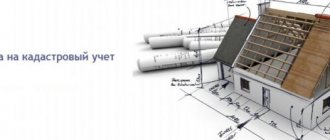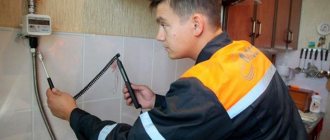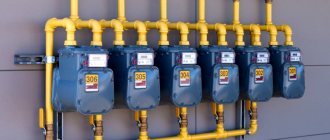Heating meter for apartment
The current tariff schedule for heating payments obliges residents to pay not for the kilowatts spent, but for the heated meters. It does not take into account whether there is heat in the room or not. This situation does not suit an increasing number of people.
There is still debate about how economically beneficial a heating meter is for an apartment, the legality of this procedure and its feasibility.
How to install a heating meter in an apartment?
As many years of practice have shown in installing heating meters in apartments, several nuances need to be taken into account:
- First of all, the heating circuit diagram is important. Thus, in houses that are more than 20 years old, vertical distribution of heating pipes is mainly found, which means that there are several risers in all rooms at once. As a rule, installing heat meters for heating in an apartment building with such a circuit is either impossible or incredibly expensive, since measuring equipment will have to be installed on each riser. In new generation apartment buildings, horizontal wiring is used, in which one riser runs to each apartment. With such a system, there are no legal prohibitions on installing the meter.
- To install a meter, you will need appropriate permission from the organization supplying heat to the house. It must indicate all the technical parameters of the heating system of an apartment building, according to which the measuring device will be selected.
- The purchased meter must be presented for evaluation by the regulatory authority , which will register it.
- Representatives of organizations that have the appropriate permission to do so are required to install heat meters for heating in apartments .
Many consumers wonder how profitable all this effort and financial investment is, and how quickly the costs will pay off. There is no definite answer, since even if the heat in the apartment is regulated and it is saved significantly, its residents will be required to pay for heating the common area - the entrance, the basement, if there is one, the staircase.
The only thing that benefits the heat consumer when the meter is running is the ability to turn off heating in rooms where it is not needed. In this case, costs are significantly reduced, which will immediately be reflected in the payment document.
There is no need to install individual heating meters in an apartment if it has not had additional thermal insulation, for example, on the floor or walls, especially if they are external.
Why power engineers may be against the devices you want to install:
1. This is our own operating experience or operation in neighboring areas.
2. Litigation on the scale of regions and even our country (this also happened, read on the Internet). We know about them, but the purpose of our article is not advertising, but to help the consumer!
3. Ease of service for some and inconvenience for others.
4. Difficulty in repairing devices from certain factories, lack of service centers in the area, city, region.
5. Poor interchangeability of devices.
According to the law on the protection of consumer rights, the manufacturer is obliged, within 12 years after the end of production of a certain type of device, to maintain its service (read repair). But in practice, many factories change type, brand, and sizes almost every year. By the way, this indicates that the devices are “crude”; they entered the market too early.
6. An established fleet of devices in a city, district, or region.
In this case, you will be politely advised not to install these devices. Is it worth listening? Yes. Why? If you don’t listen, your accounting center will become an outcast in the future. A heat meter is a very complex device. To study its design, operation, and programming, specialists from the energy supply organization need time. And if you take into account their low earnings, contrary to the opinion of the population, they are second only to teachers, the constant shortage of staff, they will simply relegate you to the background, I strictly act according to the law. And there are so many loopholes in our law that your heat meter may remain non-commercial for years, especially if you entrusted its installation to random people.
The most incredible thing that has turned out recently is that those who install devices from new companies , promising you golden grief, also do not know them and do not know how to work with them. This is marketing, a low purchase price from the manufacturer to capture a new region, they don’t have time to study, whoever grabs it first gets the profit, but the consumer suffers. After all, there is no guarantee. that the devices will be of high quality and easy to use.
The only legal refusal to install the heat meter you have chosen is the presence at the enterprise of an existing or being implemented automated control system (automatic control system and collection of information from metering devices). But here is your direct benefit. Readings from your devices will be taken automatically; you will not need to run around and stand in line at customer service departments to pay your hard-earned money for the heat consumed. Ideally, the reading service will be free. But even if it’s paid, it’s much cheaper than the services of an organization that takes readings manually.
How do you still choose the heat meter that is most suitable for your home?
We collect data:
- Let's decide if we have a basement? Is it damp or damp, basement or underground? Heated or not.
- Where do the pipes enter the basement? In accordance with clause 3.1.5. accounting rules “The metering unit for thermal energy, mass (or volume) and coolant parameters is equipped at a heat point owned by the consumer in a place as close as possible to its head valves.” The new rules for commercial metering do not contradict this - clause 19 of these rules states - Metering units are installed in a place as close as possible to the border of the balance sheet ownership of pipelines, taking into account the real possibilities at the site.
- Next, you need to decide if the location is in a heating point, how it is lit, whether it is ventilated or not, how far the heating point is from the entrance of pipelines into the building and from the interface between you and the energy supply organization.
- What is the water quality in your area?
- What is the coolant pressure at the entrance to the building? The pressure can be taken according to the technical conditions of the energy supply organization, but it is better to look at it yourself at the ITP or central heating point (heating point). Energy engineers usually indicate the pressure at the heat source; designers must make the hydraulic calculations themselves. But only a few people do it, and is it right?!
- How is the temperature regulated at your heat source – the boiler room? Regulation can be qualitative or quantitative. Qualitative - the temperature of the coolant depends on the temperature outside. This mode is used in most small boiler houses. Quantitative - the temperature regime is constant, does not depend on the temperature outside, the flow of coolant supplied to your apartments from your own heating point changes. This is typical for cities with thermal power plants. Although in our country they also use central heating stations for high-quality weather control.
- How is the house supplied with hot water? Are there water heaters and where are they located? You may have direct water supply - you take water from the heating network. Heaters can be located at your place or at the boiler room.
- How many pipes go to the house - two, three or four.
- What is the material of the pipes, the approximate year of their installation or replacement?
- At what distance in the house relative to the heating point and (or) input is the input electrical panel. When it is mounted. His condition. How often does the power go out in the house? Do unauthorized persons have access to the intended installation location of the heat meter?
- Are the heating system pipelines insulated, with what and when? Are the pipes in the basement insulated?
- How many apartments and residents are there in the house? This is necessary for accurate calculation of water heaters and selection of hot water flow meters, so that you will not be left without it in the future.
- Is there a DHW (hot water) recirculation line in the house?
We have collected the data - now we can decide on the type of heat meter. Only after everything you have learned will you say, I’d better go to the designers. And you will be absolutely right. Some of the data will be given to you by the energy supply organization in the form of technical conditions. They will collect the rest themselves. We’ll talk about where to find and how to choose a design organization a little later. But I will still tell you for what conditions certain heat meters are not suitable.
I hope that you have already read the articles “ On the types and design of heat meters ”, “ How to install a heat meter correctly ”, “ Heat meter - savings or losses?! " If not, read it so that I don’t repeat myself and everything is clear to you.
Let's carry out a preliminary selection of the heat meter:
The water quality is poor or the water is aggressive and contains a lot of salts - we discard mechanical heat meters. Now their installation is generally questionable, metering rules do not openly prohibit the use of water meters, but mechanical water meters do not support reversibility - read metering in reverse (for example, when a leak in a heating main leaves a house without water). New custody transfer regulations require the installation of reversible flow meters.
The pressure difference between the supply and return pipelines of the heating plant is less than 0.7 kgf/cm2 - we discard mechanical, ultrasonic - imported ones, vortex heat meters are also questionable. The electricity in the house is often turned off, and unauthorized persons may have access to the installation site of the heat meter, especially those who monitor the “excessive energy consumption” - these are mostly grandmothers, which means it is necessary to install a heat meter with a completely autonomous (battery) power supply. If such a “grandmother” turns off the power to the heat meter: “whose lights are on empty,” then at the end of the month you simply will not have any readings.
There is not enough space in the heating station - electromagnetic heat meters will help out, but keep in mind that they are afraid of dampness. By the way, vortex heat meters are best suited to dampness, but if there is air in the heating system, they can lie not in your favor. They also work very poorly where they steal electricity.
Electromagnetic heat meters work well with diameters up to 150 mm, are very stable, and under certain conditions can be used outside buildings, on the street.
In outdoor conditions, vortex heat meters are probably indispensable, but they need large straight sections before and after the flow meters, and good compensating devices for shear from thermal expansion of pipelines, good mesh filters must have a magnetic insert. And again, vortex flowmeters do not support reversibility. Now that you have roughly understood what you need, we will decide on a design organization.
Installation nuances
In order for the entire procedure for installing a heat meter to be legal, the following sequence of actions must be followed:
- get permission;
- draw up a plan for installing the meter and the work to be carried out;
- choose a company that will install the device and register it;
- installation of the meter;
- signing an agreement with the organization installing the device on control and metering of consumed heat;
- test the equipment.
Unauthorized installation of a heat meter for heating in an apartment building will entail serious problems, which will most likely result in a large fine and dismantling of the equipment.
What should it be?
Are there heating meters in the apartments?
Today, 2 types of heating measuring instruments are known:
- Mechanical , in which impellers that are immersed in water are used to determine the amount of liquid flowing through the system.
- Ultrasonic ones , although more expensive, are reliable and provide more accurate readings. In them, the amount of liquid is determined using ultrasound.
As a rule, most companies involved in permitting documentation and installation of measuring instruments insist on purchasing ultrasonic models. This is due to the fact that such meters for heating batteries in an apartment are difficult to deceive in order to reduce their performance in any way.
In addition to such meters, there are so-called heat consumption analyzers , which are installed directly on the surface of the radiator. Their program contains parameters for reading the heat of the air and the heat transfer of the heating device itself.
The only thing that needs to be done is to enter the battery parameters into its memory, and if in Europe they have long been replacing the complex installation of heat meters for apartment heating, then they are just coming to the post-Soviet space and are very expensive.
Before installing heating meters in your apartment, you should understand how they work.
How does the heating meter work in an apartment?
The principle of operation of a heating meter in an apartment:
- The flow meter determines how much water flows through the heating system. It is mounted in the supply pipe and gives readings for a certain unit of time.
- Temperature sensors indicate forward and return flow data.
- The electronic computer summarizes all the indicators and displays the resulting figures on the amount of heat consumed on the display.
Consumers who use an individual heat meter for heating an apartment note a significant reduction in the cost of paying for heating using the meter in an apartment building, but this is not due to a reduction in tariffs, but to their personal control of heat consumption.
Construction Materials
— materials for the construction and repair of buildings and structures.
Along with the “old” materials such as wood, tar, stone and brick, with the beginning of the industrial revolution new building materials appeared - concrete, steel, glass and plastic.
Tar
obtained by dry distillation (heating at high temperatures without air access) of hard or brown coal, peat, and wood. Depending on the source material, tar is divided into coal tar, lignite tar, peat tar, and wood tar. Tar binders are used for the production of roofing, waterproofing and vapor barrier materials, road, roofing and waterproofing mastics and for the preparation of concrete.
The most important for the construction industry are tars obtained from the coking of coal. Gas tars are formed when gas is produced from fuel. Depending on the coking temperature, tars are classified as high- and low-temperature
.
High- and low-temperature coal tars are divided into raw, distilled and compounded
. Raw high-temperature tar is not used directly for the production of building materials, since it contains water and many volatile components used by other industries as independent products.
Distilled high temperature tar is obtained from raw tar by separating water, light and medium oils. With further distillation, heavy and anthracene oils are released from the tar, and the residue is coal tar. Coal Pitch
- a black solid substance obtained after distilling almost all oil fractions from tar. In waterproofing work, coal tar pitch is used to create impregnating waterproofing for concrete structures.
Coal tar
- a viscous dark brown or black liquid consisting of hydrocarbons.
Coal tars contain phenols (compounds with antiseptic properties), as well as benzene, toluene, xylene, naphthalene and many other substances widely used in the chemical industry to produce various synthetic products. Tar density is 1.08-1.35 g/cm3. Coal tar
is produced by the coking process of coal. They are used in anti-corrosion work in the manufacture of epoxy-coal tar coatings for metal waterproofing.
Tar roofing mastic
is a mixture of tar binder made from an alloy of coal tar pitch and oil or pitch and coal tar with a fibrous, combined or dust filler. Medium coal tar pitch with anthracene oil can also be used as a binder. For tar mastics, the same fillers are used as for bitumen ones.
Tar mastics are prepared both in the factory and directly on the construction site in boilers with fire or electric heating. At a mastic cooking plant, mastic is prepared in cooking and mixing blocks. Key indicators
Hot tar mastic is also heat resistance, flexibility and adhesive ability. Tar or resin is first loaded into the prepared boiler, where they are dewatered with constant stirring (with a hand mixer or mechanical blades). Then medium pitch is served and at the same time the temperature in the boiler is increased to 150-160 ° C with continuous stirring. The alloy is boiled until completely dehydrated and a homogeneous mass is obtained.
Information sources:
- Construction Materials. Wikipedia.
- Tar binders and materials based on them.
- Technologies for the protection of building structures. Tar mastic materials.
Meter installation
As a rule, installation and installation of heating meters in an apartment building does not take much time, but requires compliance with a number of rules:
- A place must be selected for the device to which there will be free access for checking it and taking readings.
- For installation, choose a flat place on the pipe , since any bends will negatively affect the measurements.
- The temperature sensor is installed with its clamp extending to the middle of the cross-section of the heating pipe.
- To prevent airing of the system and thus changing the accuracy of the readings, a fitting must be installed in front of the meter .
- To simplify the removal of an already installed measuring device, ball valves must be installed before and behind it .
For many consumers, the most pressing question is how much a heating meter costs for an apartment. As practice shows, this concept includes not only the cost of a heating meter in an apartment building, but also permits, installation, and maintenance. Therefore, in each specific case the cost may be different.
Video material
Installing a heating meter in an apartment allows you to significantly save money when paying utility bills. In addition, you will only pay for those services that were actually provided. So your intentions are correct, all that remains is to implement them.










